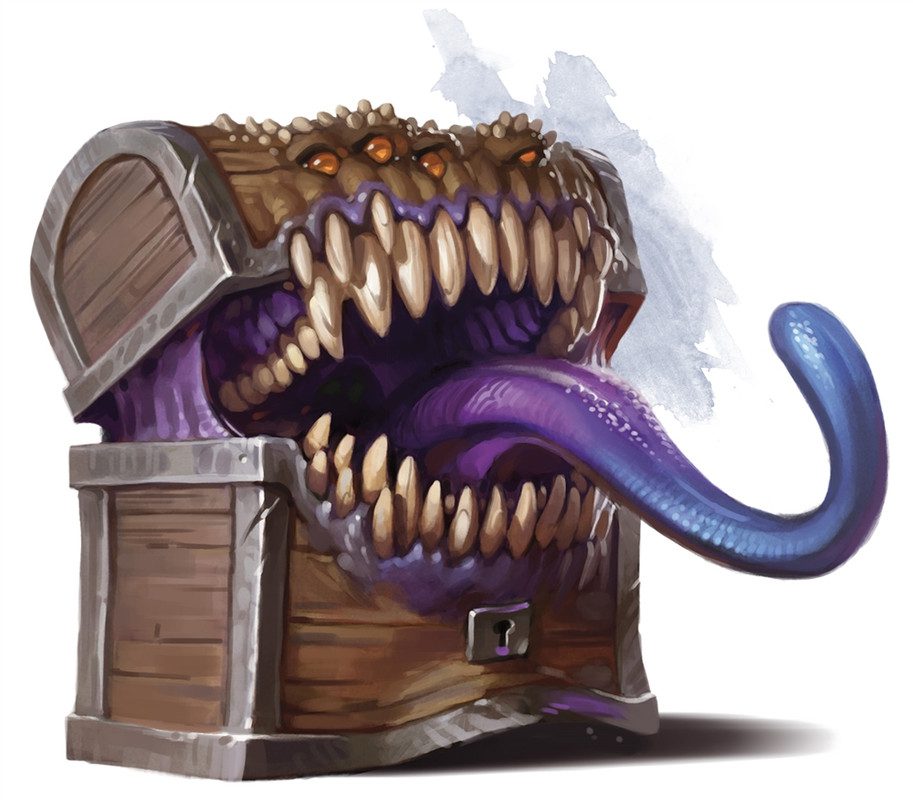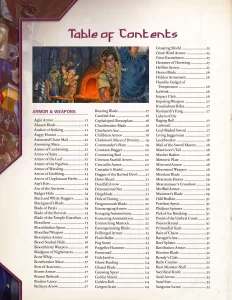
The Mimic, a perplexing and perilous creature of myth and reality, resides in the shadowy crevices of dungeons and remote landscapes. Often dismissed as mere fairy tales, the Mimic, in actuality, boasts a stunning complexity that few have delved into, as they are divided into a rich tapestry of related species that create two distinct categories.
The first group, referred to as the "killer" variety, is brutish and primitive. These are the nightmarish incarnations that attack indiscriminately, their minds driven by insatiable hunger and predatory instincts. Possessing little intelligence, they are mute and unyielding, their every thought bent on the thrill of the hunt.
Conversely, the second category of Mimic is a refined, eloquent, and often misunderstood species. They are characterized by an intelligence that goes far beyond their appearance. These creatures are capable of engaging in trade and barter, often negotiating with their would-be prey for food or other commodities. Remarkably, they possess a unique language that has yet to be deciphered by scholars. A melodic yet cryptic tongue, it resonates with the echoes of ancient wisdom. In addition, they frequently communicate in commonly spoken languages such as Orcish, Common, Dwarvish, and other regional dialects, adjusting themselves to the linguistic landscape of their hunting grounds.
The etymology of the name "Mimic" lies in the creature's uncanny ability to transform its body's shape, color, and texture. This extraordinary skill allows the Mimic to imitate objects such as wood or stone, facilitating its stealth and camouflage. This metamorphosis is accomplished by a complex dance of pigmented liquid, shifting between the interior and exterior cells of its body.
In its natural state, a Mimic exhibits a gray hue, with an exterior so smooth and hard that it mirrors the appearance of stone. The pigmented liquid, a mysterious brownish concoction, resides within the body's large muscular organs. These organs serve dual functions as both reservoirs and pumps, storing the pigmented liquid until needed.
When the Mimic wishes to alter its appearance, the cavity wall muscles contract, causing the organs to exude their contents rapidly into the outer skin layer. The capillaries just beneath the skin's surface are then filled, rising to the surface in a brownish, wrinkled pattern that closely resembles wood grain. It is a sight both breathtaking and terrifying, often only revealed to adventurers when a Mimic is wounded in battle.
Yet, the Mimic is not solely a creature of violence and deception. Its biology is a marvel of nature, a testament to the infinite possibilities of life. Researchers who have dared to study the Mimic have noted that its adaptability extends to social structures, dietary preferences, and even artistic expressions, manifested in the intricate designs it can create with its skin.
Its dual nature, both killer and scholar, predator and philosopher, is a reminder that the world is filled with mysteries yet to be unraveled. In the dark corners of the world, where the unknown lingers, the Mimic stands as a symbol of the unfathomable complexity and beauty of existence, waiting to be discovered by those brave enough to seek the truth.

Reversing the process, from the wood-grain appearance to the natural state, requires a sort of external contortion; a Mimic appears to wriggle and twist all over as it empties its capillaries of the liquid. (The creature can, as we all know, alter the external configuration of its form at will, within the limits imposed by the actual volume of its form.) The mimic grows replacement layers of skin beneath the outer one, which is constantly being worn away by the ravages of movement, battle, and feeding.
The Mimic is amorphous and moves in the same way it attacks: by extending strong pseudopods, which exude a sticky "glue," and pulling themselves along. A Mimic can "unstick" its own glue at any time, and it never sticks to itself.
Reputedly, this glue is sticky enough that only the strongest of adventurers has a good chance of breaking the Mimic's hold without killing the creature first. Some adventurers claim to have pulled themselves free from a Mimic's glue, but such tales are rare and often their veracity is doubtful: to simulate the possibility of breaking free in game terms, held characters may be allowed to attempt an "open doors" roll based on their strength. Repeated attempts to break free may be made, but no other action - attack or defense - is possible by the victim during the round of attempted escape.
Mimics are interested only in personal safety and an endless quest for food. "Killer" Mimics will attack any living creature, regardless of the number of adversaries or their powers. The more intelligent variety often prefers to bargain with an enemy initially Š but the creatures have no moral standards as we know them: If an enemy is sufficiently weakened after a bargain has been struck, a Mimic will "change its mind," always seeking a meal first and foremost.
Mimics have very sensitive "eyespots" (patches of pigment that are sensitive to heat; light, and vibration) all over their skin. Bright sunlight overwhelms these sensory spots, effectively blinding the Mimic; thus, the creatures are almost always found below ground or in other areas where the sun never reaches. Mimics of all sorts are immune to the deleterious effects of alcohol (but will absorb it if offered, to make use of the inherent nutrients and sugar) and are also unaffected by slime (including green slime), molds (including the brown and yellow varieties), and the corrosive secretions of creatures such as the black pudding, gray ooze, ochre jelly, stun-jelly, and gelatinous cube.
It should be remembered that Mimics can travel on walls and ceilings as easily as they can on floors. Those of the more intelligent sort are most adept at "hiding" by assuming the shape of a partition wall, overhanging arch, or rough rock wall if they feel threatened.
One famous, if somewhat extreme, example: A Mimic somehow came into one of the busiest market squares of Waterdeep and assumed the shape of a statue. It remained undetected for two winters, until the chronic disappearance of street derelicts in the square on every dark night prompted an investigation. A sewer beside this strangely unfamiliar (to the sculptor who had "done" the square) statue was discovered to be filled to a depth of more than 60 feet with human and animal bones. (Even after this fact was discovered, the "statue" ate two members of the City Watch who prodded it carelessly with their spears, not expecting to find anything.)
Although the details of the concoction are not known by this scribe, it is generally said that the skin of the Mimic is useful in the making of a polymorph (self) potion. Also, further investigation is needed to determine the range of travel of an individual Mimic over a lifetime, and the precise efficacy of the creature's detection organs, which, based on casual observation, appear to "see" up to 90 feet in subterranean (not total) darkness, and up to 30 feet in the gloom of night, or in darkened areas above ground.






